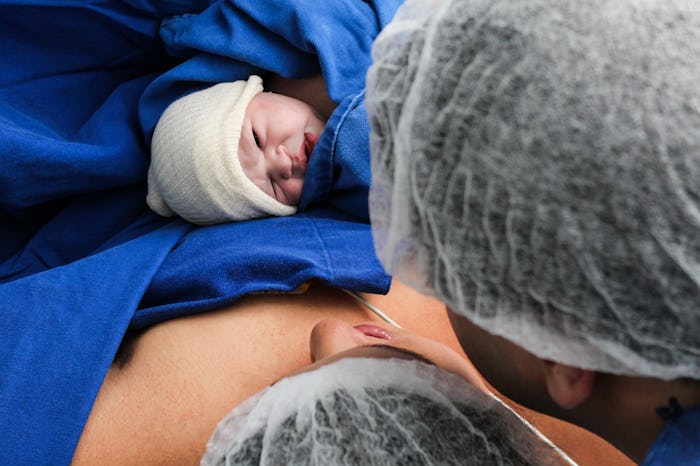Life
Even If You Have A C-Section, Skin-To-Skin Care Can Still Be Part Of Your Birth Plan
If you're pregnant, then by now you've already heard all of the ins and outs about unmedicated versus medicated births and why you can tell everyone to go shove it when they share unsolicited opinions about how to feed your baby. But it's likely that you've also read a lot about skin-to-skin contact after birth. According to experts, skin-to-skin care — simply put, your baby's skin on your skin — should begin as soon as possible after birth. But what if things don't go as planned (because, really, when do they ever)? Can you do skin-to-skin with a C-section?
"Moms can absolutely do skin-to-skin care during a C-section," Dr. Lakeisha Richardson, a board-certified OB-GYN tells Romper in an email interview. "Most women who have a C-section have spinal anesthesia, which means that they are paralyzed from the waist down."
But, Richardson explains, mothers are still awake during their C-section, meaning that immediately after the delivery, a nurse can take the baby behind the surgical drape and place the baby on mom's chest. "Mom is allowed to move her arms and hold the baby as long as they stay behind the surgical drape," she says. "The baby will have to be moved while mom is transitioned from the operating table to a bed; however, as soon as mom is stable in recovery, the baby will be placed back on mom's chest."
Richardson says that not only is skin-to-skin care important in early mother-baby bonding, but it also helps babies stabilize their body temperature, breathing, and heart rate sooner. "Skin-to-skin care also increases the chances for successful breastfeeding and early latching, and reduces crying."
Sue Pedaline, who is a registered nurse and holds a doctorate of nursing practice, agrees, adding that skin-to-skin also normalizes a baby’s blood sugar and reduces stress for the infant. It may also decrease the need for transfer to the neonatal intensive care unit, she says.
"For the mother, skin-to-skin care with her baby after a surgical delivery offers a more positive birth experience," Pedaline tells Romper. "Traditionally, moms who deliver via cesarean section got to see their baby from a distance. They are separated for up to hours and can leave moms with negative feelings about the birth."
Pedaline, who is also the chief nursing officer for Women’s Hospital in Greensboro, North Carolina, says many programs are working to change that. For instance, Women's Hospital has a dedicated nurse in the operating room who is focused solely on skin-to-skin care while the surgery is being completed. The nurse dedicated to this process partners with the anesthesiology provider to ensure the mom is tolerating the procedure while offering skin-to-skin care.
"If the mother is unable to hold her baby skin-to-skin while her procedure is completed, the father of the baby or support person can do skin-to-skin care right beside the mother," Pedaline says.
Like Pedaline, Leigh Anne O’Connor, an International Board Certified Lactation Consultant (IBCLC) and parenting coach, tells Romper in an email interview that it is important that a partner or doula be available to assist a mother "as they may be a bit weak after the birth. The baby’s other parent can also offer skin-to-skin."
In fact, many partners say they felt a deeper connection after taking time for skin-to-skin with their newborns. "It was incredible, and I have never felt so much love for my baby, for my wife, and our new family," Mohammad noted in a Romper article. "It was very emotional for me."
If you have questions or concerns about skin-to-skin care following a C-section, then chat with your healthcare provider about your wants following birth and learn more about their protocol in the delivery and/or surgical room.
After all, your birth experience should be as unique to you as it possibly can be.
Check out Romper's new video series, Romper's Doula Diaries:
Check out the entire Romper's Doula Diaries series and other videos on Facebook and the Bustle app across Apple TV, Roku, and Amazon Fire TV.
